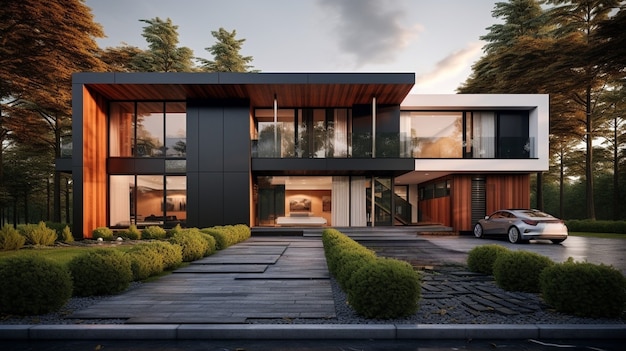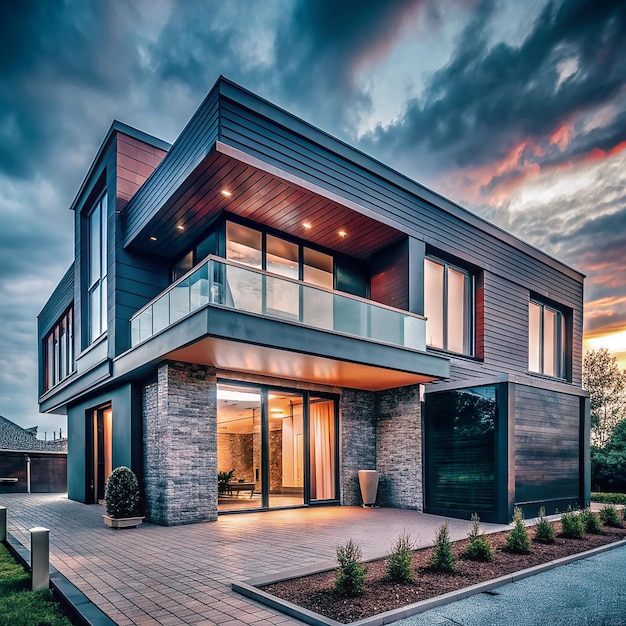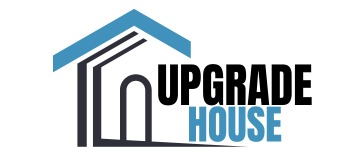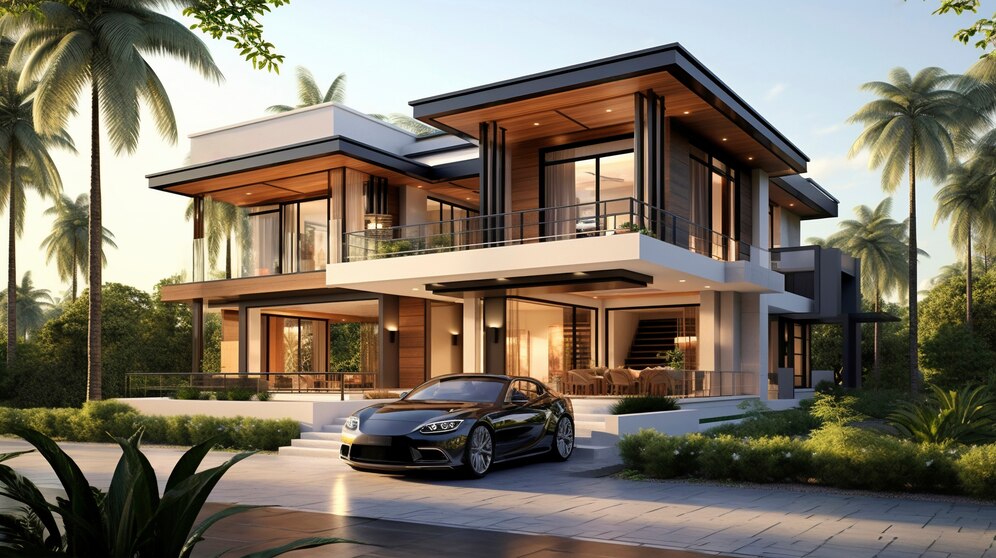
Explore the world of modern houses with this in-depth guide. Discover the key design elements, trends, and innovations that define contemporary architecture. From open floor plans to sustainable features, learn how to bring modernity into your home with expert tips and insights.
The Evolution of Modern Houses
Modern houses have undergone a remarkable transformation from their early beginnings to the present day. Initially, the concept of modernity in housing emerged in response to the rapid technological and social changes of the late 19th and early 20th centuries. Early modern architecture was characterized by its rejection of historical styles and ornamentation in favor of simplicity, functionality, and the use of new materials. As industrialization advanced, architects began to explore new possibilities, leading to the development of innovative design principles that continue to influence contemporary modern houses. The evolution of modern houses reflects broader cultural and technological shifts, from the minimalist approaches of the early 20th century to the sophisticated, sustainable designs of today.
Key Characteristics of Modern Houses
Modern houses are distinguished by several key characteristics that collectively define their aesthetic and functional qualities. One of the most prominent features is the emphasis on open floor plans, which create a sense of spaciousness and fluidity within the home. This design approach often includes large, uninterrupted spaces that blend living, dining, and kitchen areas, allowing for greater flexibility and a more cohesive living experience. Additionally, modern houses frequently incorporate large windows and glass doors to maximize natural light and establish a strong connection with the outdoors. The use of clean lines, geometric shapes, and minimalist decor further enhances the modern aesthetic, emphasizing simplicity and clarity.
The Role of Natural Light in Modern House Design
Natural light plays a crucial role in modern house design, influencing both the aesthetic appeal and functionality of contemporary homes. The strategic placement of windows, skylights, and glass doors allows for an abundance of natural light to penetrate the interior spaces, creating a bright and inviting atmosphere. This emphasis on natural light not only enhances the visual appeal of the home but also contributes to a healthier and more enjoyable living environment. Moreover, the integration of outdoor spaces, such as patios and gardens, further blurs the lines between indoor and outdoor living, allowing residents to experience the benefits of natural light in various settings.

Sustainable Design Practices
Sustainability has become a fundamental aspect of modern house design, reflecting a growing awareness of environmental issues and a commitment to reducing the ecological footprint of residential construction. Modern houses often incorporate a range of eco-friendly features, including energy-efficient appliances, renewable energy sources, and sustainable building materials. The use of high-performance insulation, low-energy windows, and advanced HVAC systems helps to minimize energy consumption and reduce greenhouse gas emissions. Additionally, sustainable design practices extend to landscaping and water management, with features such as rainwater harvesting systems and native plantings that contribute to the overall environmental stewardship of the property.
The Impact of Technology on Modern Houses
Technology has revolutionized the way we live, and modern houses are at the forefront of this transformation. The integration of smart home technology has become a defining feature of contemporary residential design, offering homeowners increased convenience, security, and efficiency. Smart home systems allow for the automation of various functions, including lighting, heating, cooling, and security, all of which can be controlled remotely through smartphones or voice-activated devices. This level of control not only enhances the overall functionality of the home but also contributes to a more streamlined and comfortable living experience. The incorporation of cutting-edge technology in modern houses reflects a commitment to innovation and a desire to stay connected in an increasingly digital world.
Minimalist Design Principles
Minimalism is a key principle of modern house design, characterized by its focus on simplicity and functionality. The minimalist approach emphasizes the use of clean lines, uncluttered spaces, and a restrained color palette to create an environment that is both aesthetically pleasing and practical. This design philosophy encourages the elimination of unnecessary elements, allowing the inherent beauty of the space and its materials to take center stage. By prioritizing quality over quantity and embracing a “less is more” mindset, minimalist design creates a sense of calm and order that is both timeless and contemporary.

Adding Unique Touches to Modern Homes
While modern house design adheres to certain principles, there is ample opportunity for customization and personalization. Homeowners can infuse their unique style into modern houses by selecting bespoke furniture, artworks, and decor that reflect their individual tastes. Customization allows for the creation of spaces that are not only visually striking but also deeply personal and meaningful. Whether through the incorporation of personal collections, the selection of vibrant accents, or the use of custom-built features, personalization adds depth and character to modern homes, ensuring that they remain a true reflection of their occupants.
The Influence of Cultural Trends on Modern House Design
Modern house design is not limited to a single style or aesthetic; instead, it encompasses a diverse range of influences and cultural trends from around the world. Architectural practices and design philosophies from different regions contribute to the richness and variety of contemporary homes. For example, Scandinavian design emphasizes functionality and simplicity, while Japanese architecture often incorporates elements of Zen and natural harmony. The integration of these diverse influences into modern house design reflects a global perspective and a willingness to embrace and adapt various cultural traditions and innovations.
Outdoor Living Spaces
Outdoor living spaces have become an integral part of modern house design, offering additional areas for relaxation and entertainment. Contemporary homes often feature expansive terraces, patios, and gardens that seamlessly connect with the indoor living areas. These outdoor spaces are designed to extend the functionality of the home, providing opportunities for outdoor dining, lounging, and recreational activities. The incorporation of features such as outdoor kitchens, fire pits, and swimming pools enhances the appeal of these areas, making them an essential component of modern living.
The Role of Interior Design in Modern Houses
Interior design plays a crucial role in shaping the overall aesthetic and functionality of modern houses. The selection of furnishings, materials, and color schemes contributes to the creation of a cohesive and harmonious living environment. Modern interior design often emphasizes a balanced combination of form and function, with a focus on creating spaces that are both visually appealing and practical. The use of high-quality materials, innovative designs, and thoughtful layouts ensures that each room serves its intended purpose while contributing to the overall modern aesthetic of the home.

Innovative Building Materials
The use of innovative building materials has been a key factor in the evolution of modern house design. Advances in construction technology have led to the development of new materials that offer enhanced performance, durability, and aesthetic appeal. For example, the use of prefabricated panels, modular components, and advanced concrete formulations has transformed the way modern houses are built. These materials not only contribute to the efficiency of the construction process but also enable architects and designers to explore new design possibilities and create unique architectural features.
The Significance of Functionality in Modern Home
Functionality is a fundamental aspect of modern house design, ensuring that each space within the home serves a practical purpose while contributing to the overall aesthetic. Modern houses are designed to accommodate the needs and preferences of their occupants, with a focus on creating efficient and versatile living environments. This includes the incorporation of features such as flexible room layouts, ample storage solutions, and multi-purpose furniture. By balancing form and function, modern houses offer a living experience that is both aesthetically pleasing and highly functional.
The Future of Modern House Design
As technology and societal trends continue to evolve, the future of modern house design is likely to be shaped by emerging innovations and new design philosophies. Future trends may include the increased use of sustainable materials, advancements in smart home technology, and the integration of health and wellness features into residential design. Architects and designers are likely to explore new ways to enhance the functionality, efficiency, and aesthetic appeal of modern homes, creating spaces that are both forward-thinking and adaptable to changing needs.
The Role of Landscaping in Modern House Design
Landscaping is an important aspect of modern house design, contributing to the overall aesthetic and functionality of the property. Thoughtful landscaping can enhance the connection between the indoor and outdoor spaces, creating a harmonious environment that complements the architectural style of the home. This includes the use of native plants, outdoor lighting, and hardscaping elements such as pathways and retaining walls. By integrating landscaping into the design process, homeowners can create outdoor spaces that are both visually appealing and functional, enhancing the overall living experience.

Modern Houses and Sustainability
Sustainability is a key consideration in modern house design, reflecting a commitment to environmental stewardship and responsible resource management. Modern houses often incorporate a range of eco-friendly features, such as energy-efficient systems, sustainable materials, and water conservation technologies. This commitment to sustainability extends to the overall design and construction process, with an emphasis on reducing waste and minimizing the environmental impact of the home. By embracing sustainable practices, modern houses contribute to a healthier planet and a more sustainable future.
The Influence of Personal Style on Modern House Design
Personal style plays a significant role in modern house design, allowing homeowners to create spaces that reflect their individual tastes and preferences. The incorporation of unique design elements, such as custom furnishings, artwork, and decorative accents, adds a personal touch to modern homes. By tailoring the design of their homes to fit their personal style, homeowners can create environments that are not only aesthetically pleasing but also deeply meaningful and reflective of their own identities.
Modern Houses and Community Integration
Modern house design also considers the integration of homes within their broader community context. This includes creating designs that enhance social interactions, foster a sense of belonging, and contribute to the overall character of the neighborhood. Features such as communal spaces, pedestrian-friendly pathways, and landscaping that connects with surrounding areas help to create a sense of community and enhance the quality of life for residents. By prioritizing community integration, modern houses contribute to the development of vibrant and cohesive neighborhoods.
The Impact of Modern Architecture on Urban Development
Modern architecture has had a profound impact on urban development, influencing the way cities are designed and experienced. Contemporary buildings and design principles have reshaped skylines, transformed neighborhoods, and contributed to the evolution of urban environments. The emphasis on functionality, sustainability, and aesthetic appeal in modern architecture has led to the creation of dynamic and adaptable urban spaces that cater to the needs of diverse populations. As cities continue to grow and evolve, modern architecture will play a crucial role in shaping their future.

The Aesthetic Appeal of Modern Houses
The aesthetic appeal of modern houses is a reflection of the balance between beauty and function. Modern design principles emphasize clean lines, geometric forms, and a minimalist approach, creating visually striking and harmonious spaces. This focus on aesthetics is complemented by a commitment to functionality, ensuring that each design element serves a practical purpose while contributing to the overall visual impact of the home. By achieving this balance, modern houses offer a unique and captivating living experience that is both beautiful and functional.
The Psychological Benefits of Modern House Design
Modern house design has been shown to have psychological benefits, contributing to the overall well-being of its occupants. The emphasis on natural light, open spaces, and minimalist aesthetics creates environments that promote relaxation, reduce stress, and enhance mental clarity. Additionally, the incorporation of sustainable features and innovative technologies contributes to a sense of environmental responsibility and satisfaction. By creating spaces that support physical and mental health, modern houses offer a holistic approach to well-being that extends beyond the physical attributes of the home.
Conclusion
Modern houses represent a dynamic and evolving approach to residential design, reflecting a commitment to innovation, sustainability, and personal expression. From the historical evolution of modern architecture to the key characteristics and design principles that define contemporary homes, the concept of modernity encompasses a wide range of influences and trends. By embracing modern design elements and incorporating personal touches, homeowners can create spaces that are both functional and aesthetically pleasing, reflecting their unique style and values. As the field of modern house design continues to evolve, it will undoubtedly offer new opportunities for creativity, sustainability, and personal expression.
Read also: green kitchen cabinets Embracing Elegance and Freshness





